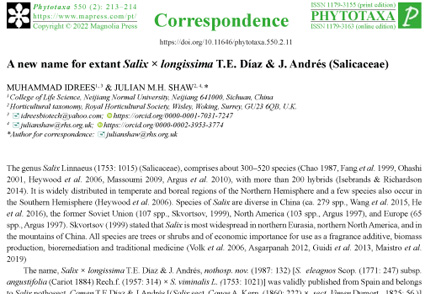Abstract
The genus Salix Linnaeus (1753: 1015) (Salicaceae), comprises about 300–520 species (Chao 1987, Fang et al. 1999, Ohashi 2001, Heywood et al. 2006, Massoumi 2009, Argus et al. 2010), with more than 200 hybrids (Isebrands & Richardson 2014). It is widely distributed in temperate and boreal regions of the Northern Hemisphere and a few species also occur in the Southern Hemisphere (Heywood et al. 2006). Species of Salix are diverse in China (ca. 279 spp., Wang et al. 2015, He et al. 2016), the former Soviet Union (107 spp., Skvortsov, 1999), North America (103 spp., Argus 1997), and Europe (65 spp., Argus 1997). Skvortsov (1999) stated that Salix is most widespread in northern Eurasia, northern North America, and in the mountains of China. All species are trees or shrubs and of economic importance for use as a fragrance additive, biomass production, bioremediation and traditional medicine (Volk et al. 2006, Asgarpanah 2012, Guidi et al. 2013, Maistro et al. 2019).
References
<p>Argus, G.W., Eckenwalder, J.E. & Kiger, R.W. (2010) Salicaceae. <em>In</em>: Flora of North America Editorial Committee (Eds.) <em>Flora of North America</em> 7. Oxford University Press, New York, pp. 3–164.</p>
<p>Asgarpanah, J. (2012) Phytopharmacology and medicinal properties of <em>Salix aegyptiaca</em> L. <em>African Journal of Biotechnology</em> 11: 7145–7150. https://doi.org/10.5897/AJB12.418</p>
<p>Chao, N. (1987) On the distribution of Salicaceae in China. <em>Acta Phytotaxonomica Sinica</em> 25: 114–124.</p>
<p>Díaz, T.E. & Andrés, J. (1987) Aportaciones al conocimiento del género <em>Salix</em> L. (Salicaceae) en la provincia de Léon (NW España). <em>Acta Botanica Malacitana</em> 12: 111–150.</p>
<p>Fang, C.F., Zhao, S.D. & Skvortsov, A.K. (1999) Salicaceae. <em>In</em>: Wu, Z.Y. & Raven, P.H. (Eds.) <em>Flora of China</em> 4. Science Press, Beijing & Missouri Botanical Garden Press, St. Louis, pp. 139–274.</p>
<p>Guidi, W., Pitre, F.E. & Labrecque, M. (2013) Short-rotation coppice of willows for the production of biomass in East-ern Canada. <em>In</em>: Matovic, M.D. (Eds.) <em>Biomass Now—Sustainable Growth and Use</em>. Rijeka, InTech: Croatia, pp. 421–448. [http://www.intechopen.com/books/biomass-now-sustainable-growth-and-use]</p>
<p>Heywood, V.H., Brummitt, R.K., Culham, A. & Seberg, O. (2006) Salicaceae, <em>Salix</em>. <em>In</em>: Heywood, V.H., Brummitt, R.K., Culham, A. & Seberg, O. (Eds.) Flowering plant families of the world. Royal Botanic Gardens, Kew, London, 424 pp.</p>
<p>Isebrands, J.G. & Richardson, J. (2014) <em>Poplars and willows: trees for society and the environment</em>. Boston, USA: The Food and Agriculture Organization of the United Nations and CABI, 634 pp.</p>
<p>Linnaeus, C. von (1753) <em>Species Plantarum</em>. Impensis Laurentii Salvii, Holmiae [Stockholm], 1200 pp.</p>
<p>Maassoumi, A.A. (2009) Experimental taxonomy of the genus <em>Salix</em> L. (Salicaceae) in Iran. <em>Iranian Journal of Botany</em> 15: 3–20.</p>
<p>Maistro, E.L., Terrazzas, P.M., Perazzo, F.F., Gaivão, I.O.N.D.M., Sawaya, A.C.H.F. & Rosa, P.C.P. (2019) <em>Salix alba</em> (white willow) medicinal plant presents genotoxic effects in human cultured leukocytes. <em>J.ournal of Toxicology and Environmental Health. Part A.</em> 82: 1223–1234. https://doi.org/10.1080/15287394.2019.1711476</p>
<p>Ohashi, H. (2001) Salicaceae of Japan. <em>Science Reports of the Tohoku Imperial Univsity, Series 4, Biology</em> 40: 269–396.</p>
<p>Portela-Pereira, E., Capelo, J.H., Neto, C.S. & Costa, J.C. (2013) Síntese do Conhecimento Taxonómico do Género <em>Salix</em> L. em Portugal Continental. <em>Silva Lusitana</em> 21 (1): 103–133.</p>
<p>Skvortsov, A.K. (1999) Willows of Russia and adjacent countries. <em>Faculty of Mathematics and Natural Sciences Report Series</em> 39. University of Joensusu Press, Joensusu, pp. 1–307.</p>
<p>Turland, N.J., Wiersema, J.H., Barrie, F.R., Greuter, W., Hawksworth, D.L., Herendeen, P.S., Knapp, S., Kusber, W.-H., Li, D.-Z., Marhold, K., May, T.W., McNeill, J., Monro, A.M., Prado, J. Price, M.J. & Smith, G.F. (Eds.) (2018) International Code of Nomenclature for algae, fungi, and plants (Shenzhen Code) adopted by the Nineteenth International Botanical Congress Shenzhen, China, July 2017. <em>Regnum Vegetabile</em> 159. Koeltz Botanical Books, Glashütten, 254 pp. https://doi.org/10.12705/Code.2018</p>
<p>Volk, T.A., Abrahamson, L.P., Nowak, C.A., Smart, L.B., Tharakan, P.J. & White, E.H. (2006) The development of short-rotation willow in the northeastern United States for bioenergy and bioproducts, agroforestry and phytoremediation. <em>Biomass and Bioenergy</em> 230: 715–727. https://doi.org/10.1016/j.biombioe.2006.03.001</p>
<p>He, L., Liao, S., Chen, S.P. & Zhang, Z.X. (2016) Nomenclatural notes of <em>Salix wangiana </em>and <em>S. zangica </em>var. <em>tibetica </em>(Salicaceae). <em>Phytotaxa </em>245 (1): 71–74. https://doi.org/10.11646/phytotaxa.245.1.8</p>
<p>Wang, L., Jia, Y., Zhang, X. & Qin, H. (2015) Overview of higher plant diversity in China. <em>Biodiversity Science </em>23: 217–224. https://doi.org/10.17520/biods.2015049</p>
<p>Weber, C.O. (1855) Beiträge zur Naturgeschichte der Vorzeit. <em>Palaeontographica </em>4: 1–206. [https://www.biodiversitylibrary.org/page/12130428]</p>


